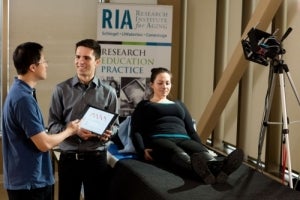 We introduce the concept of Coded Hemodynamic Imaging (CHI), where an innovative, highly-compact pulsed lighting and detection apparatus captures light fluctuations over time and space on various parts of the body simultaneously using spatiotemporal-coded pulse sequences. These spatiotemporal light fluctuation measurements are then relayed to a digital signal processing unit from which blood-flow patterns can be computed. CHI enables touchless monitoring of vital signs that could lead to improved detection and prevention of some cardiovascular issues, as well as greater independence for older adults.
We introduce the concept of Coded Hemodynamic Imaging (CHI), where an innovative, highly-compact pulsed lighting and detection apparatus captures light fluctuations over time and space on various parts of the body simultaneously using spatiotemporal-coded pulse sequences. These spatiotemporal light fluctuation measurements are then relayed to a digital signal processing unit from which blood-flow patterns can be computed. CHI enables touchless monitoring of vital signs that could lead to improved detection and prevention of some cardiovascular issues, as well as greater independence for older adults.
CHI is the first portable system that monitors a patient's blood flow at multiple arterial points simultaneously and without direct contact with the skin. Traditional systems in wide use now take one blood pulse reading at one spot on the body. On the other hand, CHI acts like many virtual sensors that measure blood flow behaviour on various parts of the body. This is analogous to being able to measure the traffic flow across an entire city (CHI) rather than just through one intersection (traditional systems).
CHI ideal for assessing patients with painful burns, highly contagious diseases, or infants in neonatal intensive care whose tiny fingers make traditional monitoring difficult. Continuous data collection at different parts of the body provides a more complete picture of what’s happening in the body. Whole-body imaging opens doors for advanced monitoring that can’t be done with the traditional, single-point methods.
An example video of the CHI system monitoring blood-flow patterns through the neck and face (slowed down to 1/6 normal speed):
The CHI technology received widespread international media coverage, including TV appearances:




Related people
Directors
Alexander Wong, David A. Clausi
Students
Alumni
Related research areas
Related publications
Journal articles
Amelard, R., C. Scharfenberger, F. Kazemzadeh, K. J. Pfisterer, B. S. Lin, A. Wong, and D. A. Clausi, "Non-contact transmittance photoplethysmographic imaging (PPGI) for long-distance cardiovascular monitoring", Nature Scientific Reports, vol. 6, no. 5, October, 2015. Details
Conference papers
Amelard, R., C. Scharfenberger, A. Wong, and D. A. Clausi, "Illumination-compensated non-contact imaging photoplethysmography via dual-mode temporally-coded illumination", SPIE Photonics West, Multimodal Biomedical Imaging X, February, 2015. Details
Amelard, R., C. Scharfenberger, A. Wong, and D. A. Clausi, "Non-contact assessment of melanin distribution via multispectral temporal illumination coding", SPIE Photonics West, Multimodal Biomedical Imaging X, February, 2015. Details




